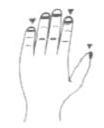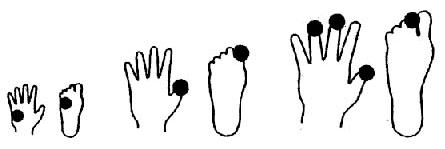How to Use an Oximeter Probe


Standard US shipping included (We ship internationally daily)
Product Description
Limitations
When using an oximeter, there are several situations that may yield invalid results. See Using an Oximeter for more details. Also the subject must not be moving around while taking measurement; otherwise the measurement would be unsteady and not reliable.
Instruction for Use
Adult and Pediatric sensor
| Select a suitable site for the sensor. The first finger is the preferred location. Alternative sites recommended are the thumb, little finger or the large toe. |
Recommended position |
| Fit the finger as illustrated in the picture (right), the patient?s finger must be inserted right to the end of the sensor. When use the adult sensor, make sure that the bottom of fingernail is rightly at the position of the mark in the side of the sensor to get accurate measurement. |
Correct inserting |
| The sensor should be oriented in such a way that the cable is positioned along the top of the hand. |
Cable position |
| Plug the sensor into the monitor and verify proper operation as described in the instrument's operator manual. |
Connect to monitor |
Hold the connector rather than the cable when connecting or disconnecting the finger sensor to the oximeter.
NOTE: Do not twist unnecessarily or use excessive force then using, connecting, disconnecting, or storing the finger sensor.
Wrap sensor
Refer to the following pictures to select a suitable site for the sensor.
3 Kg and above
|
Recommended position |
|
Recommended measuring method |
Ear sensor
Refer to the following pictures to select a suitable site for the sensor.
|
Recommended positions |
Using an ear clip probe can be tricky. For more information on how to use an ear clip sensor, read the article How to use ear clip oximeter probe for moer details.
Limitations
When using an oximeter, there are several situations that may yield invalid results. See Using an Oximeter for more details. Also the subject must not be moving around while taking measurement; otherwise the measurement would be unsteady and not reliable.
Instruction for Use
Adult and Pediatric sensor
| Select a suitable site for the sensor. The first finger is the preferred location. Alternative sites recommended are the thumb, little finger or the large toe. |
Recommended position |
| Fit the finger as illustrated in the picture (right), the patient?s finger must be inserted right to the end of the sensor. When use the adult sensor, make sure that the bottom of fingernail is rightly at the position of the mark in the side of the sensor to get accurate measurement. |
Correct inserting |
| The sensor should be oriented in such a way that the cable is positioned along the top of the hand. |
Cable position |
| Plug the sensor into the monitor and verify proper operation as described in the instrument's operator manual. |
Connect to monitor |
Hold the connector rather than the cable when connecting or disconnecting the finger sensor to the oximeter.
NOTE: Do not twist unnecessarily or use excessive force then using, connecting, disconnecting, or storing the finger sensor.
Wrap sensor
Refer to the following pictures to select a suitable site for the sensor.
3 Kg and above
|
Recommended position |
|
Recommended measuring method |
Ear sensor
Refer to the following pictures to select a suitable site for the sensor.
|
Recommended positions |
Using an ear clip probe can be tricky. For more information on how to use an ear clip sensor, read the article How to use ear clip oximeter probe for moer details.
Shipping Information
Shipping Weight: 0.00 Pounds
Availability: In stock! Ready to ship.
Shipping Cost: US Shipping included! Int'l Shipping calculated at checkout
In-stock items are normally shipped within 24-48 hours on business days. For special handling or overnight shipping, please call us at 281-664-1209.
Manufacturer Information
Manufacturer:
Item Code:
Product belongs to these categories...
Pulse Oximeter Product Support









